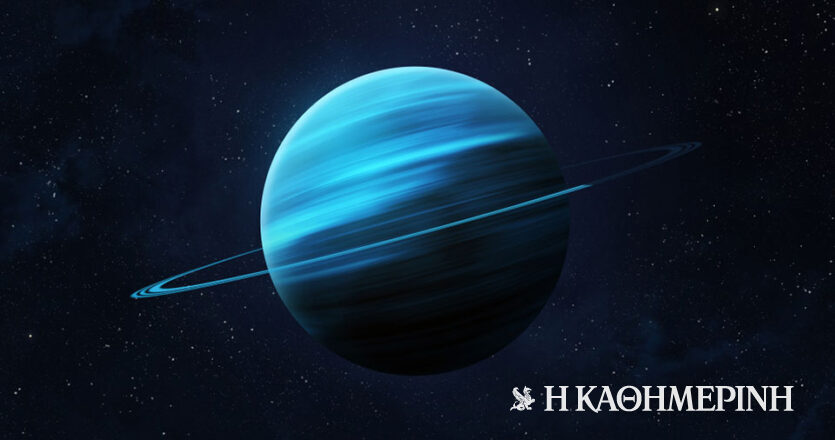
A major question has been asked in the scientific community that NASA has until 2024 to decide on its next big space mission. The scientific communities have already begun to put forward their proposals. The first choice is now Uranus, the most “unknown” planet in the solar system.
That’s because scientists know very little about this planet, which is four times the size of Earth. After all, it’s been 30 years since the Voyager 2 spacecraft took pictures of it.
Uranus completes its orbit around the Sun every 84 Earth years. Winter lasts 21 years on the planet, with temperatures reaching -371 degrees Celsius.
In fact, scientists believe that on its surface there may be a subglacial ocean and thus the possibilities for the existence of life.
Shipping 2 billion
The panel concluded that this should be the next major mission NASA has to approve by 2024.
In particular, he proposes to NASA to send a probe to Uranus – which will penetrate its unknown atmosphere – and another spacecraft that could be put into orbit around the planet for at least five (Earth) years.
The mission’s budget will exceed $2 billion.
On February 16, Kathleen Mandt of the Johns Hopkins Applied Physics Laboratory explained in an article in Science that the mission “could lead to conclusions about the origin and evolution of the solar system, as well as many other phenomena about the mysterious planet.”
With current technology, it would take the spacecraft 12 to 15 years to cover the 1.8 billion miles required to reach Uranus.
Other proposals are on the table
According to astrophysicist Fabio Favata, NASA still has many options on the table. Final decisions must be made by 2024 at the latest in order for the launch to take place within the next decade.
However, aside from Uranus, perhaps the next big mission (in a couple of decades) will be Neptune: the other frozen “giant” yet to be discovered.
On the other hand, Pluto – which is much further away and is no longer considered a planet – has been studied a lot by experts, thanks to a visit by NASA’s New Horizons spacecraft.
function gtag() { dataLayer.push(arguments); }
gtag('js', new Date());
gtag('config', 'G-JJJ7LY7JGM', { 'custom_map': {'dimension3': 'Author'} });
gtag('event', 'author_dimension', {'Author': 'Newsroom'});
}, 0)
// NEW SECOND ANALYTICS setTimeout(function () { (function (d, s, id) { var js, fjs = d.getElementsByTagName(s)[0]; if (d.getElementById(id)) return; js = d.createElement(s); js.id = id; js.async = true; js.src = "https://www.googletagmanager.com/gtag/js?id=UA-112314455-3"; fjs.parentNode.insertBefore(js, fjs); }(document, 'script', 'ga-2'));
window.dataLayer = window.dataLayer || [];
function gtag() { dataLayer.push(arguments); }
gtag('js', new Date()); gtag('config', 'UA-112314455-3');
}, 0) }; document.addEventListener("scroll", NXQuantFuncGTAG);
var NXFbPixel = function () { document.removeEventListener("scroll", NXFbPixel); setTimeout(function () { !function (f, b, e, v, n, t, s) { if (f.fbq) return; n = f.fbq = function () { n.callMethod ? n.callMethod.apply(n, arguments) : n.queue.push(arguments) }; if (!f._fbq) f._fbq = n; n.push = n; n.loaded = !0; n.version = '2.0'; n.queue = []; t = b.createElement(e); t.async = !0; t.src = v; s = b.getElementsByTagName(e)[0]; s.parentNode.insertBefore(t, s) }(window, document, 'script', 'https://connect.facebook.net/en_US/fbevents.js'); fbq('init', '109138906120213'); fbq('track', 'PageView'); }, 0) } document.addEventListener("scroll", NXFbPixel);
var NXTagManager = function () { document.removeEventListener("scroll", NXTagManager); setTimeout(function () { (function(w, d, s, l, i) { w[l] = w[l] || []; w[l].push({ 'gtm.start': new Date().getTime(), event: 'gtm.js' }); var f = d.getElementsByTagName(s)[0], j = d.createElement(s), dl = l != 'dataLayer' ? '&l=" + l : "'; j.async = true; j.src="https://www.googletagmanager.com/gtm.js?id=" + i + dl; f.parentNode.insertBefore(j, f); })(window, document, 'script', 'dataLayer', 'GTM-WWR8QSQ'); }, 0) } document.addEventListener("scroll", NXTagManager);

“Avid problem solver. Extreme social media junkie. Beer buff. Coffee guru. Internet geek. Travel ninja.”





More Stories
Android finally has a solution to annoying notifications!
Activision games are on sale on Steam!
Perhaps this is how much Sony's new flagship will cost